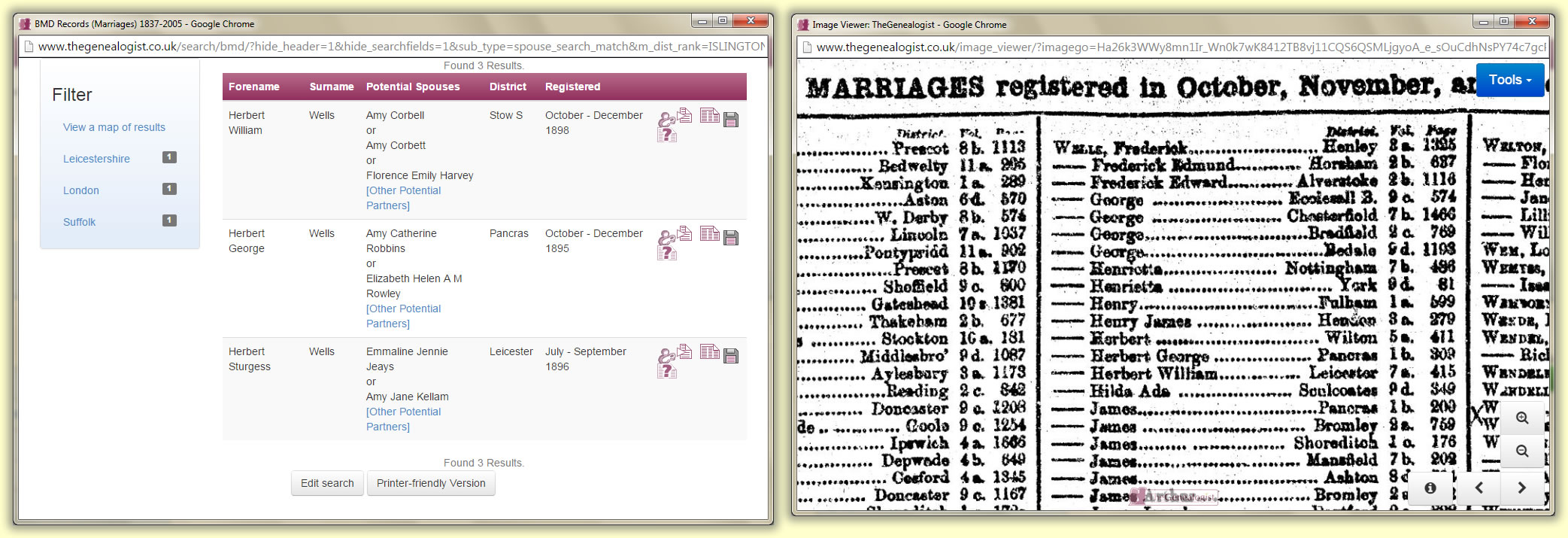
Discover Your Ancestors
Two critically acclaimed publications are available to family history researchers - the annual print magazine, Discover Your Ancestors, and the monthly online magazine, Discover Your Ancestors Periodical. Click here to subscribe. Using TheGenealogist
Using TheGenealogist
Nick Thorne explains how to get the most out of your subscription to TheGenealogist
As a member of TheGenealogist, you are free to explore the wonderful resources of TheGenealogist such as birth, marriage and death indexes (BMDs), parish records, wills, English and Welsh censuses from 1841-1911, overseas BMDs, landowner records, an image archive and a comprehensive collection of military records.
If you are new to family history see this helpful guide once you have logged in: www.thegenealogist.co.uk/researchguide. You can also view video tutorials at: www.youtube.com/thegenealogistuk.
Researching elusive ancestors
Finding our ancestors has become easier than ever as more and more records are out online, but teasing forebears out of the data depends on the approach that we use and the flexibility of the search tools at our disposal.
Working backwards from your direct relatives, you can start by looking for the details of their births, marriages and deaths. Ordering the certificates from the General Register Office will give you details of addresses, occupations and maiden names.
To find details of a parent or grandparent use the Master Search to look for them throughout the record sets available. When looking for a person, more often than not we will only have a limited amount of information to work with. The best strategy to use is to enter broad details into the search fields and then, if too many results are returned, refine down with keywords such as the county, occupation and so on.
Using the census
If you are searching for ancestors in the period from 1841 to 1911, the census is a vital tool. This gives you the names of the whole family and their occupations.
Let us look for the Pre-Raphaelite artist John Millais, who died in 1896 – see the pictures below. If he was an ancestor and you knew little more than his first name, surname and that he was alive in 1891, you could use the 1891 census to find him and his wife and children, which will then give you even more information to add into your family tree.
Using the person search you enter forename and surname and knowing that Millais was an artist, you could use this in the Keyword field. The keyword can be anything that appears on the record so you could put in this box such details as the place, the occupation, reference number and so on of your subject.
Using the Master Search you should select 'A person' and change the next drop down menu to read 'Within Census' and select '1891' and then the 'All Counties' option.
TheGenealogist returns one result and you can now select to see a transcript which will give you the names of the others in his household, as listed in the return.
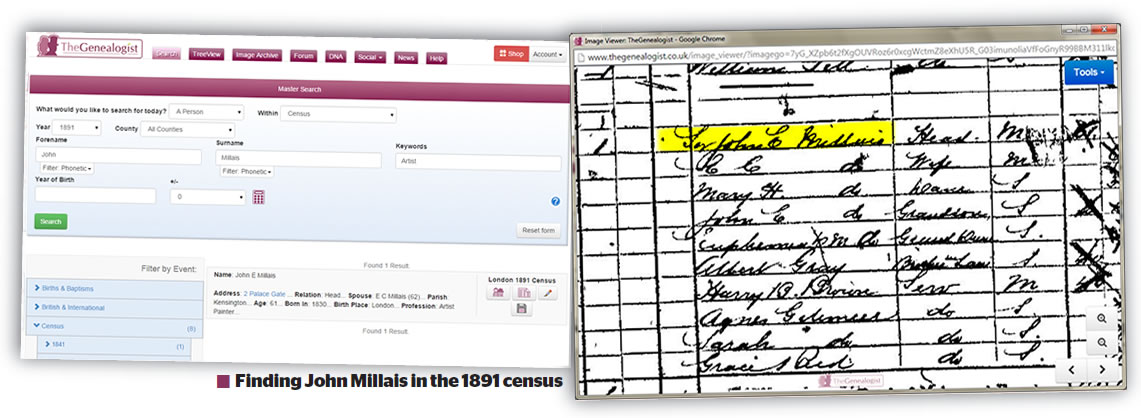
Already you are able to note his age and that of his wife. You can also see the names of his daughter, brother-in-law and the grandchildren, who were staying on the census night.
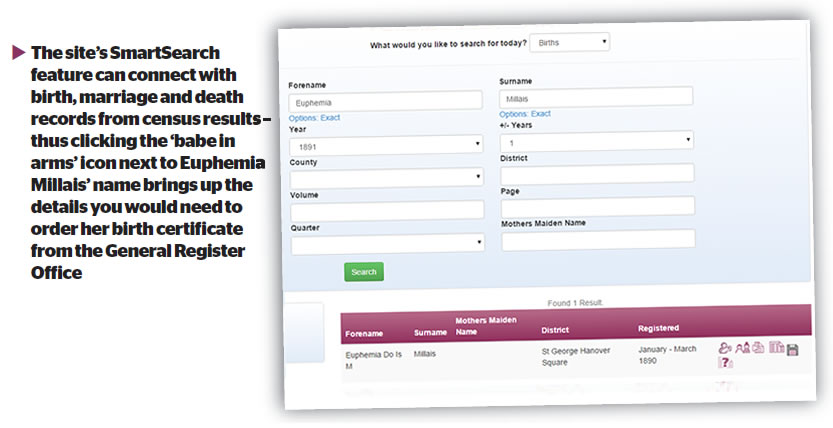 On the transcript page there is an icon of a child in arms against the names of the children and grandchildren. With one click on this you can access the powerful SmartSearch that will look for potential births in the vital records of the GRO for England and Wales. Looking for the birth of his granddaughter, you can see that Euphemia was registered in the first quarter of 1890 in the St George, Hanover Square area of London.
On the transcript page there is an icon of a child in arms against the names of the children and grandchildren. With one click on this you can access the powerful SmartSearch that will look for potential births in the vital records of the GRO for England and Wales. Looking for the birth of his granddaughter, you can see that Euphemia was registered in the first quarter of 1890 in the St George, Hanover Square area of London.
Know your ancestor's birthplace?
If you know where your ancestor was born, and want to obtain a copy of their birth certificate to gain the extra details these supply, then use the powerful Master Search to find the birth. Enter their name and in the keyword box use their birth county. From the results returned you can now order the birth certificate from the GRO (via www.gro.gov.uk/gro/content/certificates) using the page and volume details supplied.
Many of our ancestors left the established Church, perhaps for a short period, or perhaps for good. If your ancestor was a dissenter, then the Nonconformist BMDs can be included in the search. These records go back to the mid-1600's when various groups refused to conform to the Church of England and wished to have religious freedom to worship in their own way. These groups include Presbyterians, Congregationalists, Baptists, Quakers, Methodists, Catholics and Unitarians.
If you know the forenames
Ancestors with common surnames, such as Smith, are difficult to find in the census. If you only have the forenames of a family group to use, then with some online resources this is going to pose a challenge – but not for the Master Search on this site.
TheGenealogist allows you to find a family group in the census by just using the first names. The Master Search will match the forenames you enter and return family groups that include your choices.
The street where they lived
You may know that your ancestors lived in a particular street, or you want to find out who lived at a specific address at the time of the census. The facility at TheGenealogist to do an address search is an invaluable aid for family historians. You can choose to search for a street name from within the censuses from 1841 to 1911 without entering a name of a person. This can help if the enumerator misspelled your ancestor's name and you have been unable to find them in the normal way.
Maybe you know the names of an ancestor and their dwelling. Take the example of Max Gate, the house of Thomas Hardy.
You can find this famous author's details on the census (see p14). To do this, use the Keyword field in TheGenealogist's Master Search, entering 'Hardy' in the Surname box, and 'Max Gate' in the Keyword box. TheGenealogist will then find not only the correct census entries, but also Hardy in various other records.

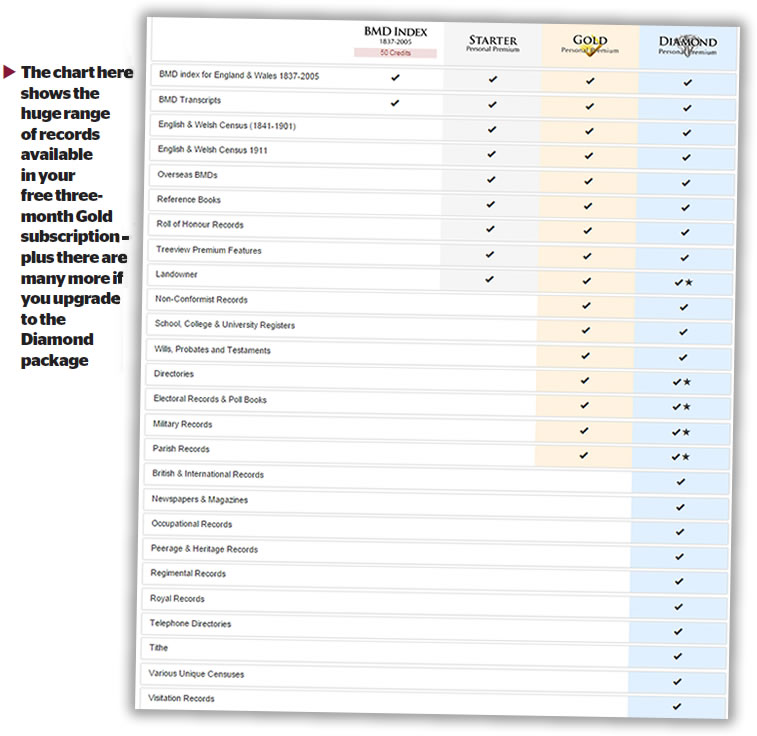 Name variations
Name variations
There may also be occasions when you are not sure of the spelling of an ancestor's surname. Perhaps the family decided to change the spelling of their surname to anglicise a name that had foreign roots and so they have been recorded by this new name in the census.
Some ancestors may have changed their surname in order to inherit from another branch of the family. Others still may have relied on the enumerator to have written their name down correctly, this official noting it down as he had heard it, perhaps using spelling that we have not considered.
The Master Search feature at TheGenealogist can help you to get beyond these pitfalls. You are able to filter the name phonetically and this tool will match different spellings for a way a name is pronounced, such as Horn/Horne/Hawn.
If you only have an initial then using the 'Standard' setting will match different combinations of the names and also looks for records that contain only initials; so a search for John Smith will give results for John Smith as well.
Using Keywords and Master Search, together with the phonetic filter if need be, can be your easiest way into finding those elusive ancestors.
Finding your ancestors can often depend on adopting a bit of lateral thinking and using a powerful search tool that allows you to dig deep into the information recorded on the original documents. In this article we have exclusively used the Master Search available to Gold subscribers and above from TheGenealogist website as it allows us to drill down into the records in so many useful ways.
In Focus: The 1911 Census
The 1911 census in the most detailed available. Here's how to find someone in it and connect it to other records.
Start your search at www.TheGenealogist.co.uk. Here we are looking for the novelist H G Wells in the 1911 census, where he is listed as Herbert George Wells. From the Master Search we have selected 'A Person' from within 'Census' and the year 1911. You can filter by county, in this case 'London', and use the occupation 'Author' as a Keyword.
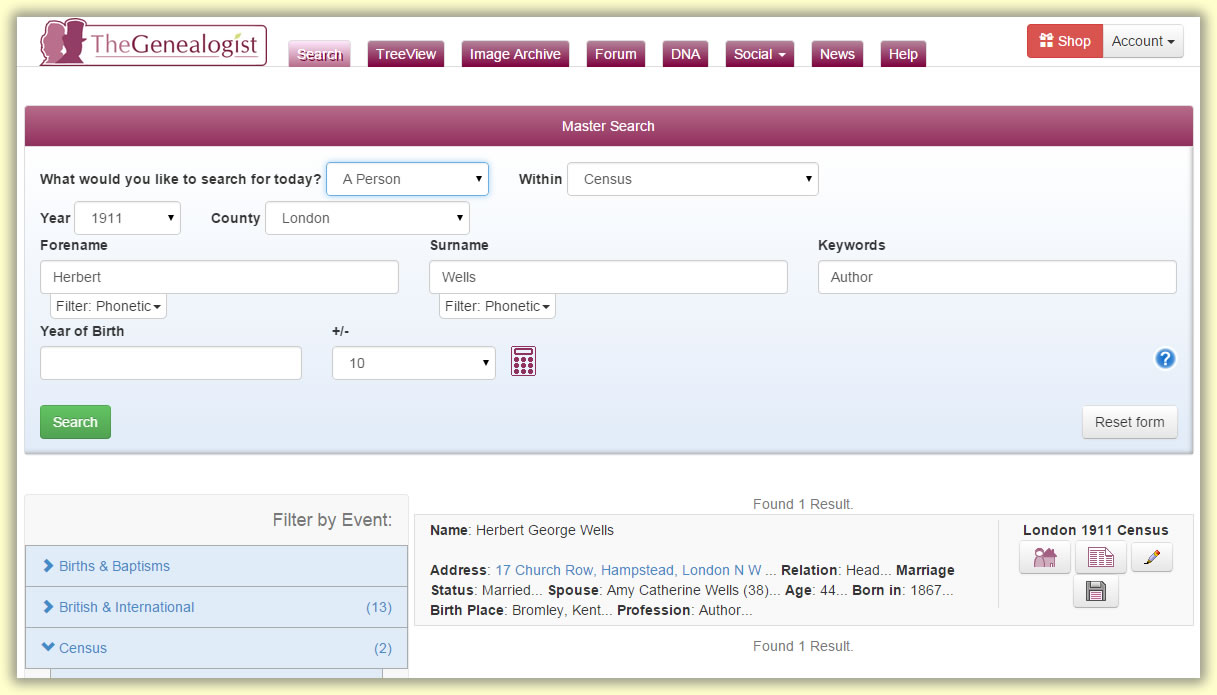
The icons bring up the transcription and the original document.
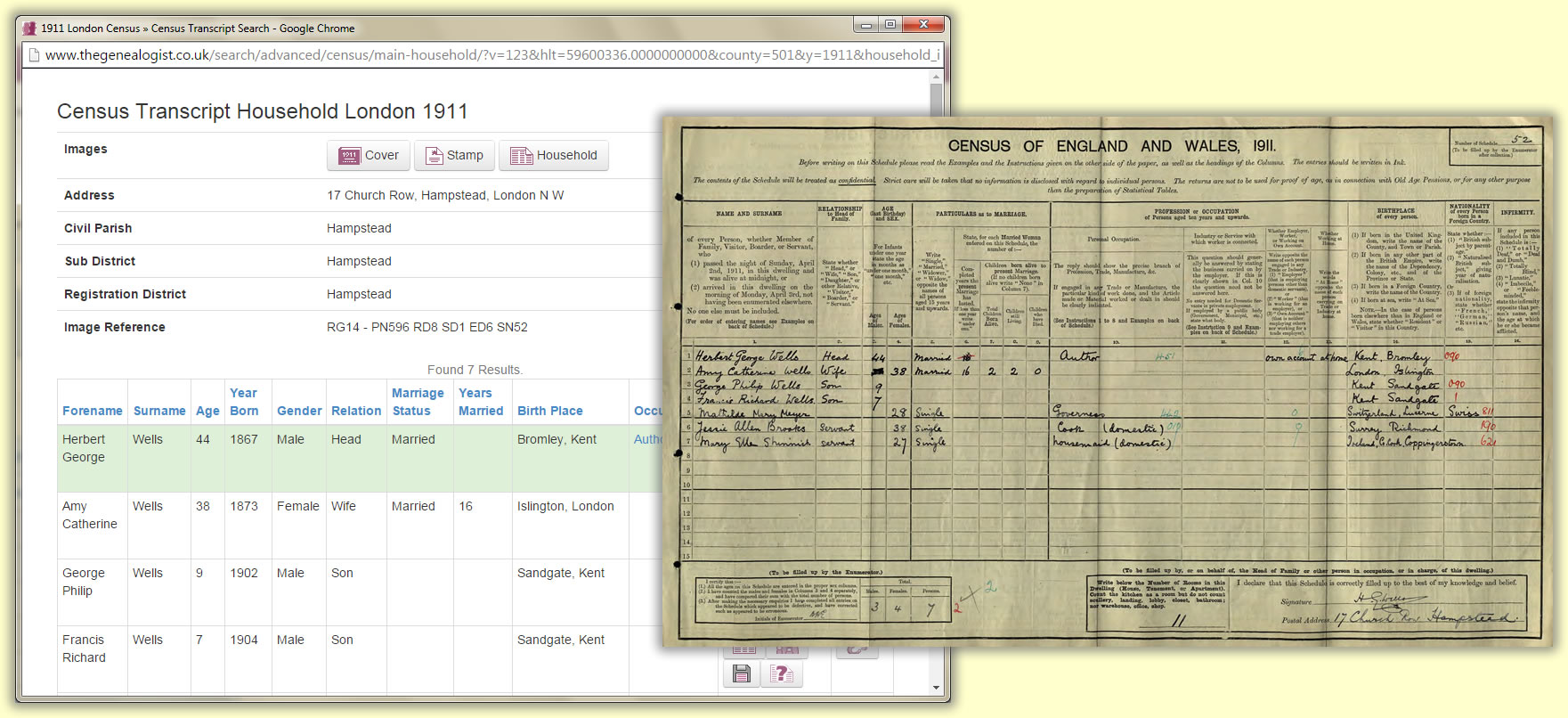
From the transcript page, one click on the marriage icon will use the powerful SmartSearch to look for potential marriages. We are looking for Amy Catherine Robbins and she is the first on the page. From these results you can click through to see the relevant General Register Office records for marriages and then order a copy of the marriage certificate from the GRO from the details revealed.
